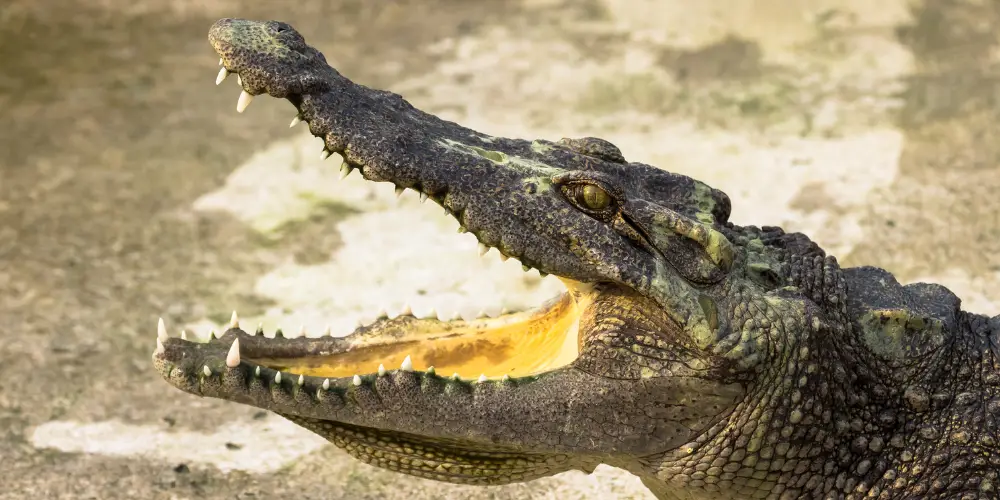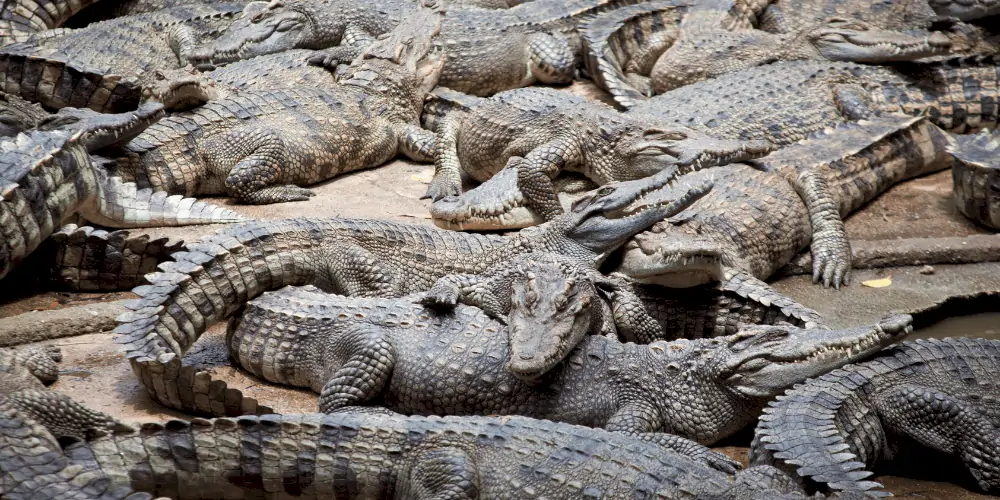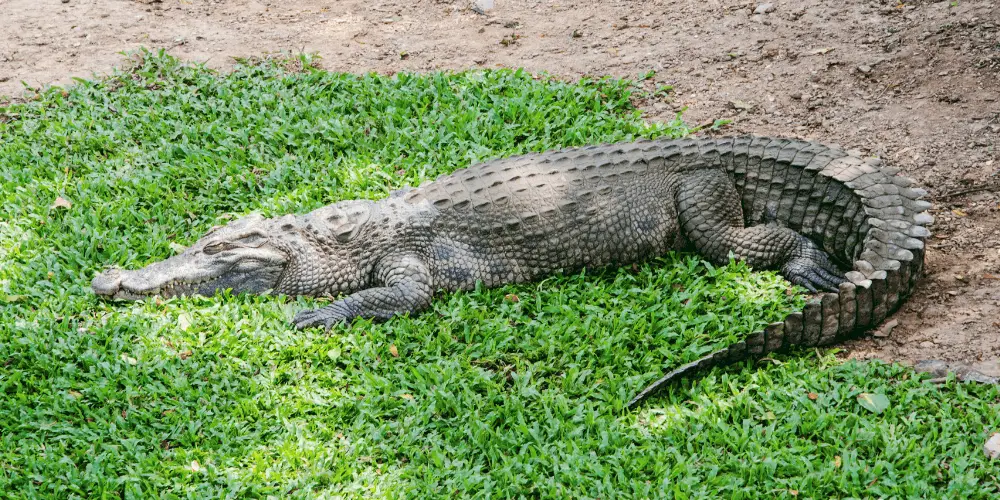“Do crocodiles have tongues?” This question might seem simple, but the answer takes us on a fascinating journey into the biology of these ancient, formidable predators.
Crocodiles have tongues. However, unlike in many animals, a crocodile’s tongue is immobile and attached to the bottom of its mouth by a membrane. It is crucial in preventing water from entering the airway when the crocodile is submerged.
Amidst the many facts and myths about crocodiles, the specifics of their oral anatomy often go unnoticed.
So, let’s delve into the lesser-known aspects of crocodile biology, dispel common misconceptions, and uncover the truth about crocodiles and their tongues.
The Anatomy of a Crocodile’s Tongue
A crocodile’s tongue is unlike the flexible, free-moving organ we humans have. Instead, it’s a relatively flat, immobile structure firmly attached to the bottom of the crocodile’s mouth by a membrane. This membrane runs along the full length of the crocodile’s snout, effectively anchoring the tongue in place.
The tongue is smooth and lacks the muscularity and texture in other animal tongues. It doesn’t have the same range of motion or flexibility, but it’s perfectly suited to the crocodile’s needs.
Interestingly, the crocodile’s tongue also houses salt glands, especially in species that live in saltwater environments. These glands help them excrete excess salt, allowing them to survive in salty waters. This is another example of how the crocodile’s tongue, while seemingly simple, is a complex and highly adapted organ.
The Crocodile’s Tongue and Taste Buds
While present, a crocodile’s tongue serves a different function than we might initially think, especially regarding taste. Crocodiles don’t use their tongues to taste food like humans and many other animals. The way crocodiles experience taste is unique.
Location of Taste Buds
Crocodiles’ taste buds are not primarily on the tongue as they are in many animals.
Instead, they are found on the roof of their mouth and the back of their tongues. This arrangement is an adaptation to their aquatic lifestyle and feeding habits.
Sensing Chemical Changes
These taste buds are crucial in helping crocodiles detect chemical changes in the water.
This ability is essential for crocodiles as it aids them in finding food. When a potential meal enters the water, it often leaves a trail of chemical signals.
The crocodile’s specialized taste buds can pick up on these signals, guiding it toward its next meal.
Sensing Danger
In addition to helping them find food, the crocodile’s taste buds also play a role in sensing danger.
Certain chemical changes in the water can signal the presence of other predators or threats.
Crocodiles can react quickly to potential danger by preparing to defend themselves or quickly exiting by picking up on these changes.
Salt Glands: A Special Feature
Crocodiles are renowned for their adaptability, and one of the most fascinating examples of this is the presence of salt glands on their tongues.
These glands, particularly prominent in saltwater species, play a crucial role in their survival in saline environments.
Saltwater crocodiles, also known as ‘salties’, are the largest living crocodilian species in the brackish and freshwater regions of eastern India, Southeast Asia, and northern Australia.
They are excellent swimmers and have often been spotted far out at sea. Their ability to thrive in such environments is largely due to their specialized salt glands.
These salt glands are located on the crocodile’s tongue and function to excrete excess salt from their bodies.
When a saltwater crocodile consumes its prey, it inevitably ingests a certain amount of salt, especially when hunting in saline waters.
The salt glands act as a sort of biological filtration system, helping to maintain a balance of salts in the crocodile’s body by excreting the excess.
This process is vital for the crocodile’s survival, as an overload of salt can harm their health.
The presence of these salt glands is a testament to the crocodile’s remarkable adaptability.
It allows them to inhabit environments that many other creatures cannot, giving them a unique advantage in the animal kingdom.
This is yet another example of how the crocodile’s tongue, while seemingly simple, is actually a complex and highly adapted organ, playing a crucial role in their survival and dominance as a species.
The Function of a Crocodile’s Tongue
A crocodile’s tongue, while immobile, plays a crucial role in the creature’s life. It serves several important functions vital to the crocodile’s survival and daily activities.
- Protection of the Airway: One of the primary functions of a crocodile’s tongue is to protect the airway. The tongue’s position and immobility help keep the throat closed, especially when the crocodile is underwater.
- Prevention of Water Entry: The immobile tongue of a crocodile also plays a crucial role in preventing water from entering its lungs. When a crocodile submerges with its mouth open, the tongue acts as a barrier, effectively blocking the entrance to the airway.
- Role in Feeding: While a crocodile’s tongue doesn’t play a significant role in manipulating food as it does in many other animals, it does contribute to the feeding process. The tongue helps maneuver food down the throat, aiding in swallowing.
Crocodile’s Tongue and Feeding
When it comes to feeding, crocodiles have a unique approach that sets them apart from many other animal species. The role of their tongue in this process is particularly interesting.
No Role in Chewing
Unlike many animals, crocodiles can’t chew their food. They lack the necessary jaw movement for this action. Instead, they rely on their powerful jaws and sharp teeth to tear apart their prey. Once the prey is in manageable pieces, crocodiles swallow it whole.
Maneuvering Food
While the crocodile’s tongue doesn’t play a part in the actual eating process, it does have a role in maneuvering food. The tongue helps guide food down the throat, aiding in swallowing. This is crucial because the crocodile could choke on its food without the tongue’s guidance.
Lack of Taste Buds
Interestingly, crocodiles don’t use their tongues to taste food like humans or other animals do. While they have taste buds, they are not on the tongue but rather on the roof of their mouth and throat. This means that the tongue’s role in feeding is purely mechanical, not sensory.
Protection During Feeding
Another important function of the tongue during feeding is to protect the crocodile’s airway. When a crocodile opens its mouth to eat, the tongue acts as a barrier that prevents food from entering the windpipe. This is particularly important given the crocodile’s method of swallowing large chunks of food whole.
While a crocodile’s tongue doesn’t play a traditional role in feeding, it is still a crucial part of the process. From maneuvering food to protecting the airway, the crocodile’s tongue is a testament to the creature’s unique adaptations and survival skills.
Crocodile Tongues vs. Other Reptiles Comparison
There are significant differences when comparing the tongues of crocodiles with other reptiles. Let’s illustrate these differences and similarities with the help of a comparison table:
| Reptile | Tongue Attachment | Tongue Mobility | Palatal Valve | Primary Function of Tongue |
|---|---|---|---|---|
| Crocodile | Firmly attached to the bottom of the mouth | Immobile | Yes | Protects airway, aids in swallowing |
| Alligator | Runs along the full length of the snout | More mobile than a crocodile’s | Yes | Aids in swallowing provides some sensory information |
| Snake | Not attached to the bottom of the mouth | Highly mobile | No | Gathers chemical information about the environment |
| Lizard | Not attached to the bottom of the mouth | Highly mobile | No | Captures prey, provides sensory information |
From this table, it’s apparent that while there are some resemblances between crocodiles and alligators, such as the presence of a palatal valve, significant differences also exist.
Alligator tongues, for instance, are more mobile than those of crocodiles. The variety becomes even more striking when we extend the comparison to include other reptiles like snakes and lizards.
These differences underscore how reptiles have adapted their tongues to cater to their specific needs and lifestyles.
Frequently Asked Questions
Can a crocodile stick out its tongue?
No, a crocodile cannot stick out its tongue. The tongue is held in place by a membrane that runs along the full length of its snouts, which prevents it from moving freely.
What does a crocodile tongue look like?
A crocodile’s tongue is flat and smooth, attached to the bottom of its mouth. It’s held in place by a membrane that runs along the full length of its snouts.
Why can’t crocodiles open their mouths?
Contrary to popular belief, crocodiles can open their mouths. However, they have a powerful bite force but relatively weak muscles to open their jaws, so it seems they can’t open their mouths wide. This is also why a human can hold a crocodile’s mouth shut with their hands.
Conclusion
Crocodiles are truly fascinating creatures, and their tongues are just one of the many intriguing aspects of their biology.
Despite being immobile, the crocodile’s tongue plays a crucial role in feeding and survival, showcasing the remarkable adaptability of these ancient reptiles.
For more fascinating insights into the world of crocodiles, check out these articles:
- How Long Can a Crocodile Go Without Eating?
- What is a Group of Crocodiles Called?
- How Fast Can a Crocodile Run?
- Can Crocodiles Regrow Limbs?
- Can Alligators and Crocodiles Climb Trees?
Understanding these magnificent creatures helps us coexist with them and protect their habitats for future generations.
So, the next time you see a crocodile with its mouth wide open, remember the hidden wonder of its tongue and the vital role it plays in the crocodile’s survival.
REFERENCES:
Crocodile. (2023, June 11). In Wikipedia. https://en.wikipedia.org/wiki/Crocodile




